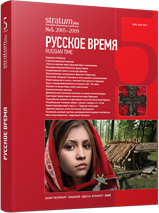Подунайские элементы в ювелирном уборе населения Восточной Европы в VII-XI вв.
Danube Elements in Jewelry Dress of East European Population in 7th-11th Centuries
Author(s): Svetlana S. RyabtsevaSubject(s): History, Cultural history, Visual Arts, Middle Ages, 6th to 12th Centuries
Published by: Издательский дом Stratum, Университет «Высшая антропологическая школа»
Keywords: Jewelry Dress; Danube; Slavic-Avar antiquities; Volhynia
Summary/Abstract: One of the topics developed by V. V. Sedov is the issue of Danube influences on the culture of East-European population. Jewelry is a very expressive marker of such influence. Several stages can be distinguished in distribution of Danube-type jewelry over Eastern Europe through history. Prague and Penkovka sites of 650 onwards were characterized by a certain set of items finding origins among the Danube antiquities (mainly miniature finger-like fibulae and lamellate pendants and galloons). Besides, sites of Prague culture yield rings with a S-shaped curl originating from the Middle Danube area. The Danube center of metalwork enhanced its influence in 700-750. Hoards of the time found in the Dnieper basin show a range of adornments (earrings with star-like and globular pendants, earrings with a banister pendant, bracelets with expanding ends), finding vast analogies among the Slavic-Avar antiquities in the Danube area. New types of adornments become common in Eastern Europe in 9th c.; they have the Danube origins and find vast analogies on sites of the Great Moravia and Bjelo-Brdo culture (bunch-like and radial rings, bracelets with expanding ends, pendants and crescent earrings). The middle of 10th c. is marked as another important turn in distribution of Danube-type adornments. The Dniester, Dnieper and Volyn lands housed masters who were producing adornments based on Danube prototypes, employing the techniques borrowed from that region. The Danube prototypes generated an integral dress decorated with granulation.
Journal: Stratum plus. Археология и культурная антропология
- Issue Year: 2009
- Issue No: 5
- Page Range: 357-380
- Page Count: 24
- Language: Russian
- Content File-PDF

